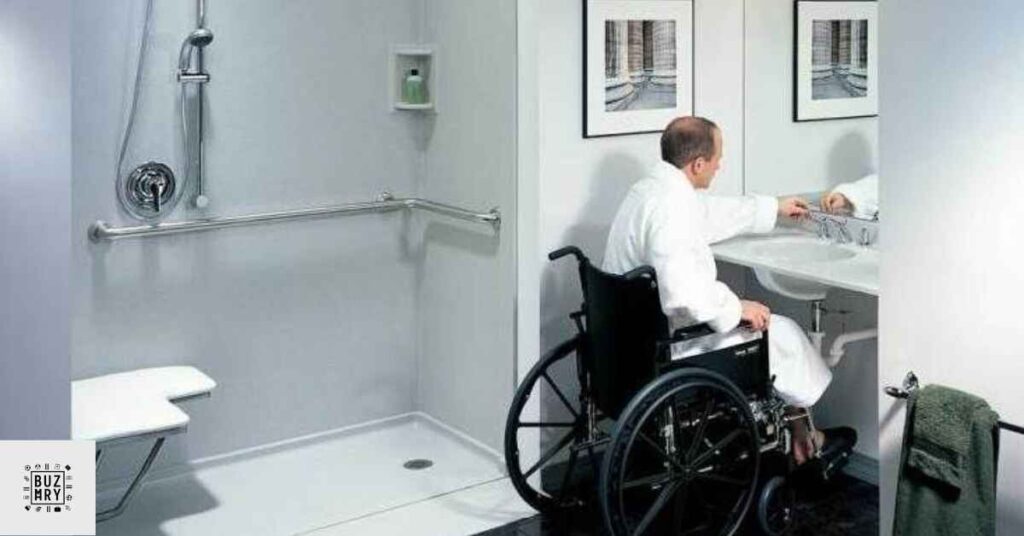Traveling with a disability presents unique challenges, particularly when it comes to bathroom accessibility during road trips. To ensure a successful journey, “Things Needed for Traveling Disabled Person Road Trips” must include proper planning and knowledge of accessible bathrooms.
Without these, disabled travelers may experience anxiety, discomfort, and face limitations that can hinder their enjoyment. Inadequate facilities can lead to uncomfortable or even dangerous situations. However, with the right information and preparation, these obstacles can be overcome.
This guide will explore the essentials for ensuring a comfortable and dignified travel experience, with a focus on bathroom accessibility.
Essential Bathroom Features for Disabled Travelers

Accessible bathrooms need specific features for disabled travelers. Wide doorways allow easy wheelchair entry. Grab bars provide support near toilets and showers. Non-slip flooring prevents accidents. Lever-style faucets are easier to use. Roll-under sinks give wheelchair access.
Emergency call buttons offer safety. Proper lighting helps visibility. These features ensure comfort and independence for disabled travelers during road trips.
Wheelchair Accessibility in Hotel Bathrooms
Truly wheelchair-accessible hotel bathrooms have key elements. The entrance is at least 32 inches wide. There’s a 5-foot turning radius inside. Toilets are 17-19 inches high with grab bars nearby.
Roll-in showers have a fold-down seat and handheld showerhead. Sinks are mounted at accessible heights with knee clearance. Mirrors are tilted or lowered for wheelchair users. These features make hotel stays more comfortable for disabled travelers.
Bathroom Size and Layout Considerations
Bathroom size matters greatly for disabled travelers. A spacious layout allows easy wheelchair maneuvering. The recommended clear floor space is 30 by 48 inches. Toilets need 18 inches of clearance on one side. Showers should be at least 36 by 36 inches. Sinks require 30 inches of width. Good layout places fixtures logically for easy access. Proper size and layout reduce stress and increase independence for disabled travelers.
Read This Blog: Cailap Oy Marketing HairAccessories: Revolutionizing the Fashion Industry
Portable Bathroom Aids for Road Trips

Portable aids enhance bathroom accessibility on road trips. Folding grab bars provide temporary support. Raised toilet seats increase comfort. Shower chairs offer seating in unfamiliar bathrooms. Portable ramps help overcome small thresholds.
Handheld showerheads improve bathing ease. Non-slip mats increase safety on wet floors. These aids are lightweight and easy to pack. They make unfamiliar bathrooms more accessible and comfortable for disabled travelers.
Shower Chairs and Transfer Benches
Shower chairs and transfer benches are crucial for disabled travelers. It’s provide stable seating during bathing. They come in various styles, including folding for easy transport. Transfer benches extend outside the tub, aiding safe entry and exit.
Some models are height-adjustable for comfort. Look for chairs with non-slip feet and drainage holes. These aids increase safety and independence in hotel bathrooms during road trips.
Handheld Showerheads
Portable handheld showerheads greatly benefit disabled travelers. They allow directed water flow while seated. Most models easily attach to existing shower fixtures.
Look for long hoses for extended reach. Multiple spray settings offer versatility. Some come with wall mounts for hands-free use. Handheld showerheads increase bathing independence and comfort. They’re lightweight and easy to pack for road trips.
Also Read This Blog: Maximizing Local Business Success with Yard Sign Marketing Data
Researching and Booking Accessible Accommodations
Finding truly accessible hotels requires careful planning. Use specialized websites tailored for disabled travelers and include “Things Needed for Traveling Disabled Person Road Trips” in your search. Read up-to-date reviews from other disabled guests, and contact hotels directly to ask about your specific needs. Request photos of accessible rooms and bathrooms to ensure they meet your requirements.
Book early to secure accessible rooms and consider the hotel’s proximity to attractions. Opt for accommodations with staff trained in disability awareness. These steps are essential for ensuring comfortable accommodations for disabled travelers on road trips.
Key Questions to Ask When Booking
When booking, ask specific questions about bathroom accessibility. Inquire about door width for wheelchair entry. Ask about grab bar placement near toilets and in showers. Check if showers are roll-in or if tubs have transfer benches.
Confirm toilet height and space around it. Ask about sink height and if there’s knee clearance. Verify if mirrors are accessible from a seated position. These questions ensure the bathroom meets your specific needs.
Public Restroom Accessibility on the Road

Public restrooms can be challenging for disabled travelers. Look for family restrooms, which are often more spacious. Use apps to locate accessible restrooms along your route. Carry a portable door stopper for extra privacy.
Pack disposable seat covers for hygiene. Bring a small flashlight for dimly lit facilities. Consider a travel urinal for emergencies. Plan rest stops in advance to reduce stress. These strategies help manage public restroom needs during road trips.
Restaurant Bathroom Accessibility
Restaurant bathroom accessibility can vary greatly, so it’s important to plan ahead. As part of “Things Needed for Traveling Disabled Person Road Trips,” call ahead to inquire about key bathroom features. Look for restaurants with clearly marked accessible entrances and ensure the path to the restroom is wide and obstacle-free.
Confirm the presence of grab bars, proper toilet height, and wheelchair-accessible sinks. Additionally, consider the overall cleanliness and maintenance of the facility. These factors will help determine if a restaurant’s bathroom meets your needs during your road trip.
Hygiene and Sanitation Considerations
Maintaining hygiene is essential for disabled travelers on road trips. As part of “Things Needed for Traveling Disabled Person Road Trips,” carry hand sanitizer for quick cleaning and pack antibacterial wipes for surfaces. Bring your own soap in case public restrooms run out, and use disposable toilet seat covers when needed.
Pack extra clothes for accidents, and stay hydrated while planning fluid intake around rest stops. These practices ensure cleanliness and comfort throughout the journey.
Portable Cleaning Supplies
Essential cleaning supplies for road trips include:
1. Travel-sized disinfectant spray
2. Antibacterial hand wipes
3. Disposable gloves
4. Small pack of tissues
5. Ziplock bags for waste
6. Travel-sized hand sanitizer
7. Portable toilet seat sanitizer
8. Odor eliminator spray
These items help maintain hygiene in various bathroom situations. They’re compact and easy to carry. Regular use of these supplies reduces health risks during travel.
Legal Rights and Accessibility Standards
Disabled travelers have legal rights to accessible facilities. The Americans with Disabilities Act (ADA) sets standards for public accommodations. This includes hotels, restaurants, and public restrooms. Businesses must provide reasonable accommodations. This covers accessible parking, entrances, and bathrooms. Knowledge of these rights helps travelers advocate for themselves. If you encounter non-compliance, you can file a complaint with the Department of Justice.
Americans with Disabilities Act (ADA) Guidelines
ADA guidelines for bathrooms include specific measurements. Doorways must be at least 32 inches wide. Toilets should be 17-19 inches high. Grab bars are required near toilets and in showers. Sinks must have knee clearance for wheelchair users.
Mirrors should be mounted no higher than 40 inches from the floor. These standards ensure basic accessibility. Familiarity with these guidelines helps travelers identify ADA-compliant facilities.
Planning Your Route with Accessibility in Mind
When planning your route, prioritize bathroom accessibility as part of “Things Needed for Traveling Disabled Person Road Trips.” Research rest stops with accessible facilities along the way, and identify cities or towns with known accessible public restrooms.
Consider the distance between reliable bathroom options, and plan meal stops at restaurants with accessible bathrooms. Have backup options ready in case your primary stops are unavailable.
Utilize accessibility-focused travel apps for real-time updates. This careful planning reduces stress and enhances overall trip enjoyment.
Creating an Accessibility-Focused Itinerary
Build your travel itinerary around accessible bathroom breaks. Plan stops every 2-3 hours, depending on personal needs. Include buffer time for unexpected delays or difficulties. Note opening hours of public facilities along your route.
Schedule longer stops at places with known good accessibility. Have a list of backup options for each planned stop. Consider booking hotels for longer breaks during extended trips. This approach ensures regular, reliable access to suitable bathrooms.
Frequently Asked Question
What is the minimum door width for wheelchair accessibility in bathrooms?
The minimum door width for wheelchair accessibility in bathrooms is 32 inches (81.28 cm). This width allows most wheelchairs to pass through comfortably and safely.
How high should grab bars be installed in an accessible bathroom?
Grab bars should be installed 33-36 inches (83.82-91.44 cm) above the floor. This height range provides optimal support for most users when transferring or maintaining balance.
Are there portable ramps available for overcoming small bathroom thresholds?
Yes, portable threshold ramps are available for bathrooms. These lightweight, foldable ramps can easily overcome small steps or thresholds, typically up to 4 inches in height.
What is the ideal height for an accessible toilet?
The ideal height for an accessible toilet is 17-19 inches (43.18-48.26 cm) from the floor to the top of the seat. This range is often referred to as “comfort height” and makes transfers easier for many users.
How can I protect my wheelchair from water damage in roll-in showers?
To protect your wheelchair from water damage in roll-in showers, use a waterproof seat cover and wheel covers. Also, dry your wheelchair thoroughly after use and regularly maintain its moving parts.
Are there waterproof covers available for electric wheelchairs for use in wet bathrooms?
Yes, waterproof covers are available for electric wheelchairs. These covers protect sensitive electronic components from water damage while allowing access to controls and maintaining mobility.
Conclusion
Planning and preparation are key to successful road trips for disabled travelers, especially when it comes to bathroom accessibility. By understanding essential features, packing portable aids, and researching accommodations thoroughly, disabled individuals can enjoy more comfortable and stress-free journeys.
Remember to prioritize hygiene, know your legal rights, and create an itinerary that accounts for regular, accessible bathroom breaks. With the right tools, knowledge, and planning, disabled travelers can overcome bathroom-related challenges and focus on the joys of exploration and adventure.
By taking these steps, the road ahead becomes more accessible, allowing for memorable and fulfilling travel experiences.
“Hassan Amjad is the dedicated travel writer for Buzsmarty.com, bringing a passion for exploration and cultural discovery to each article. With a focus on delivering practical travel tips, destination guides, and unique experiences, Hassan helps readers navigate the world with ease. His love for adventure and insightful approach ensures that travelers of all kinds find valuable, up-to-date information to enrich their journeys.



